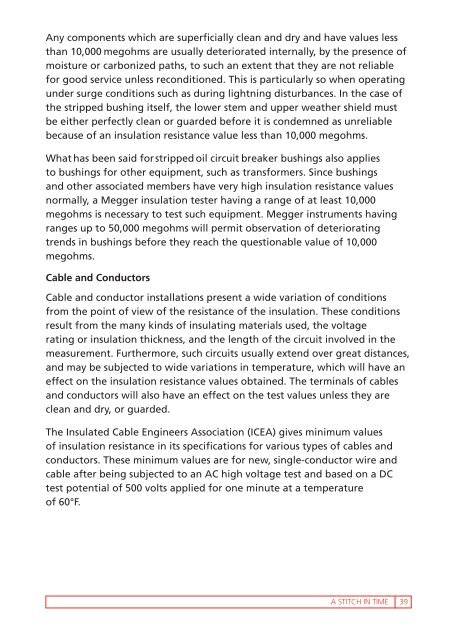“A Stitch in Time...”
Create successful ePaper yourself
Turn your PDF publications into a flip-book with our unique Google optimized e-Paper software.
Any components which are superficially clean and dry and have values less<br />
than 10,000 megohms are usually deteriorated <strong>in</strong>ternally, by the presence of<br />
moisture or carbonized paths, to such an extent that they are not reliable<br />
for good service unless reconditioned. This is particularly so when operat<strong>in</strong>g<br />
under surge conditions such as dur<strong>in</strong>g lightn<strong>in</strong>g disturbances. In the case of<br />
the stripped bush<strong>in</strong>g itself, the lower stem and upper weather shield must<br />
be either perfectly clean or guarded before it is condemned as unreliable<br />
because of an <strong>in</strong>sulation resistance value less than 10,000 megohms.<br />
What has been said for stripped oil circuit breaker bush<strong>in</strong>gs also applies<br />
to bush<strong>in</strong>gs for other equipment, such as transformers. S<strong>in</strong>ce bush<strong>in</strong>gs<br />
and other associated members have very high <strong>in</strong>sulation resistance values<br />
normally, a Megger <strong>in</strong>sulation tester hav<strong>in</strong>g a range of at least 10,000<br />
megohms is necessary to test such equipment. Megger <strong>in</strong>struments hav<strong>in</strong>g<br />
ranges up to 50,000 megohms will permit observation of deteriorat<strong>in</strong>g<br />
trends <strong>in</strong> bush<strong>in</strong>gs before they reach the questionable value of 10,000<br />
megohms.<br />
Cable and Conductors<br />
Cable and conductor <strong>in</strong>stallations present a wide variation of conditions<br />
from the po<strong>in</strong>t of view of the resistance of the <strong>in</strong>sulation. These conditions<br />
result from the many k<strong>in</strong>ds of <strong>in</strong>sulat<strong>in</strong>g materials used, the voltage<br />
rat<strong>in</strong>g or <strong>in</strong>sulation thickness, and the length of the circuit <strong>in</strong>volved <strong>in</strong> the<br />
measurement. Furthermore, such circuits usually extend over great distances,<br />
and may be subjected to wide variations <strong>in</strong> temperature, which will have an<br />
effect on the <strong>in</strong>sulation resistance values obta<strong>in</strong>ed. The term<strong>in</strong>als of cables<br />
and conductors will also have an effect on the test values unless they are<br />
clean and dry, or guarded.<br />
The Insulated Cable Eng<strong>in</strong>eers Association (ICEA) gives m<strong>in</strong>imum values<br />
of <strong>in</strong>sulation resistance <strong>in</strong> its specifications for various types of cables and<br />
conductors. These m<strong>in</strong>imum values are for new, s<strong>in</strong>gle-conductor wire and<br />
cable after be<strong>in</strong>g subjected to an AC high voltage test and based on a DC<br />
test potential of 500 volts applied for one m<strong>in</strong>ute at a temperature<br />
of 60°F.<br />
A STITCH IN TIME 39



